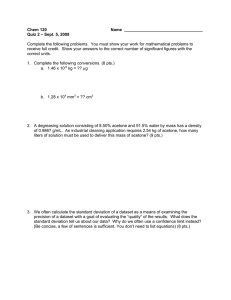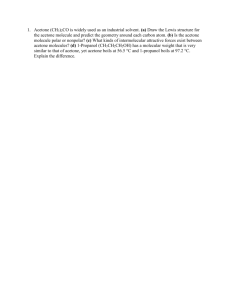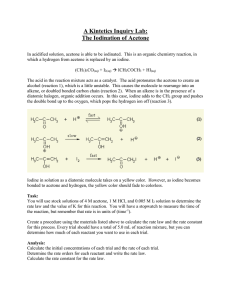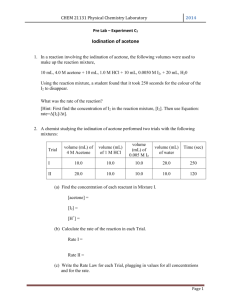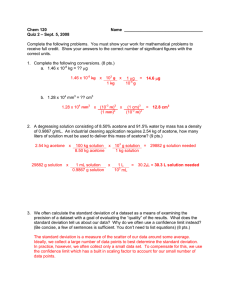Document 14105760
advertisement
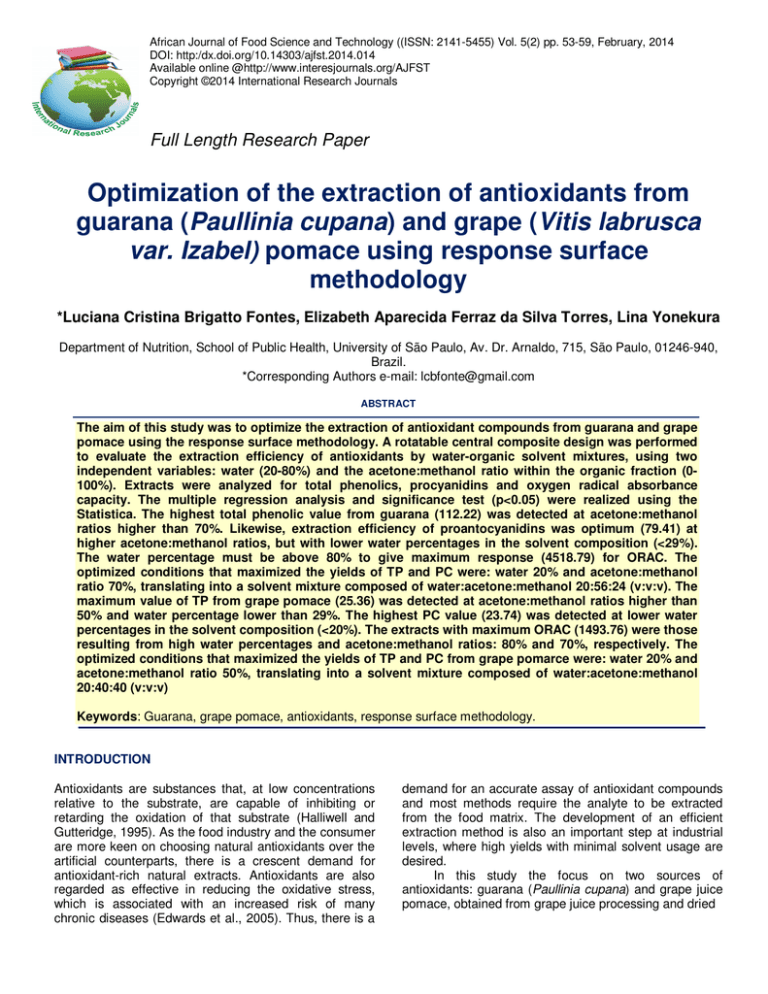
African Journal of Food Science and Technology ((ISSN: 2141-5455) Vol. 5(2) pp. 53-59, February, 2014 DOI: http:/dx.doi.org/10.14303/ajfst.2014.014 Available online @http://www.interesjournals.org/AJFST Copyright ©2014 International Research Journals Full Length Research Paper Optimization of the extraction of antioxidants from guarana (Paullinia cupana) and grape (Vitis labrusca var. Izabel) pomace using response surface methodology *Luciana Cristina Brigatto Fontes, Elizabeth Aparecida Ferraz da Silva Torres, Lina Yonekura Department of Nutrition, School of Public Health, University of São Paulo, Av. Dr. Arnaldo, 715, São Paulo, 01246-940, Brazil. *Corresponding Authors e-mail: lcbfonte@gmail.com ABSTRACT The aim of this study was to optimize the extraction of antioxidant compounds from guarana and grape pomace using the response surface methodology. A rotatable central composite design was performed to evaluate the extraction efficiency of antioxidants by water-organic solvent mixtures, using two independent variables: water (20-80%) and the acetone:methanol ratio within the organic fraction (0100%). Extracts were analyzed for total phenolics, procyanidins and oxygen radical absorbance capacity. The multiple regression analysis and significance test (p<0.05) were realized using the Statistica. The highest total phenolic value from guarana (112.22) was detected at acetone:methanol ratios higher than 70%. Likewise, extraction efficiency of proantocyanidins was optimum (79.41) at higher acetone:methanol ratios, but with lower water percentages in the solvent composition (<29%). The water percentage must be above 80% to give maximum response (4518.79) for ORAC. The optimized conditions that maximized the yields of TP and PC were: water 20% and acetone:methanol ratio 70%, translating into a solvent mixture composed of water:acetone:methanol 20:56:24 (v:v:v). The maximum value of TP from grape pomace (25.36) was detected at acetone:methanol ratios higher than 50% and water percentage lower than 29%. The highest PC value (23.74) was detected at lower water percentages in the solvent composition (<20%). The extracts with maximum ORAC (1493.76) were those resulting from high water percentages and acetone:methanol ratios: 80% and 70%, respectively. The optimized conditions that maximized the yields of TP and PC from grape pomarce were: water 20% and acetone:methanol ratio 50%, translating into a solvent mixture composed of water:acetone:methanol 20:40:40 (v:v:v) Keywords: Guarana, grape pomace, antioxidants, response surface methodology. INTRODUCTION Antioxidants are substances that, at low concentrations relative to the substrate, are capable of inhibiting or retarding the oxidation of that substrate (Halliwell and Gutteridge, 1995). As the food industry and the consumer are more keen on choosing natural antioxidants over the artificial counterparts, there is a crescent demand for antioxidant-rich natural extracts. Antioxidants are also regarded as effective in reducing the oxidative stress, which is associated with an increased risk of many chronic diseases (Edwards et al., 2005). Thus, there is a demand for an accurate assay of antioxidant compounds and most methods require the analyte to be extracted from the food matrix. The development of an efficient extraction method is also an important step at industrial levels, where high yields with minimal solvent usage are desired. In this study the focus on two sources of antioxidants: guarana (Paullinia cupana) and grape juice pomace, obtained from grape juice processing and dried 54 Afr. J. Food Sci. Technol. Table 1. Codified levels and the corresponding percentages of water and acetone/methanol in the solvent mixtures Independent variables water (%) % acetone/methanol -1.41 20 0 by a process previously developed by group (Brazilian patent pending PI0801101-0-A2). Guarana (Paullinia cupana) is a low-growing bushtype plant, native to Brazilian whose seeds are the richest vegetable source of caffeine (Mehr et al., 1996; Weckerle et al, 2003). The seeds also contain theophylline, theobromine, xanthine derivatives, catechins and tannins, which are compounds known for their antioxidant activity in vitro and associated to a number of beneficial effects on human health, (Bruneton, 1999; Henman, 1982; Seidemann, 1998; Hall; Cuppett, 1997). The production of grape juice generates large amounts of pomace, which is considered by winery industry as a residual product (Valduga et al., 2008). However, this byproduct still contains considerable amounts of phenolic compounds that have an important antioxidant activity (Rockenbach et al., 2008). Besides, the use of grape pomace can contribute to reducing the environmental impact of its disposal, as the residue corresponds to approximately 20% of grapes weight (Cruz et al, 2010). Due to their claimed antioxidant activity (Soares et al., 2008), anti-inflammatory (Castilla et al., 2006) and anticarcinogenic (Abe et al., 2007) properties, the potential health effects of anthocyanin-rich foods and beverages such as wine and grape juice have been extensively studied. Response surface methodology (RSM) is a collection of mathematical and statistical techniques for empirical model building. By careful design of experiments, it is possible to optimize the extraction process (input variables) so that analytical results (output variable, such as in vitro antioxidant activity and concentration of phytochemicals) truly reflect the amounts found in the food matrix. The solubility and extractability of phenolic compounds in food matrices depends on solvent polarity, the nature of the polyphenols (e.g. logP, degree of polymerization), the composition of the food matrix and the interactions between the compound and food matrix. Moreover, polyphenols are very reactive substances and susceptible to the action of enzymes. This fact explains the lack of a universal procedure and points to the need for careful selection and individual extraction method for each source of natural antioxidant (King; Young, 1999; Agnelo; Jorge, 2007). Although it is common to find recommendations of stepwise use of hydrophilic to lipophilic solvents to maximize extraction of constituents of varied chemical structures (Naczk, Shahidi, 2004), our experiments (Antunes, 2011) have shown that similar extraction yields of polyphenols from guarana seeds could be achieved with the use of repeated extractions with solvent mixtures. -1 29 15 0 50 50 +1 71 85 +1.41 80 100 The aim of this study was to optimize solvent mixtures for the extraction of antioxidant compounds from guarana and grape pomace using the response surface methodology. The method implies in a reduced number of experimental runs compared to the full factorial design, and allows solvent optimization for each sample at the laboratory level. MATERIALS AND METHODS Materials Guarana powder (Paullinia cupana) was a gift from Guaranapis Company, that is the largest producer of guarana in Brazil. The dry grape pomace was from Vitis labrusca var. Izabel, 2008/2009 crop (patent BR n. 018080016620 PI0801101-0-A2.) Methods The central composite rotational design (CCRD) was performed to evaluate the effect of solvent mixtures containing water, acetone and/or methanol on the extraction efficiency of antioxidants. The independent variables were: water content (20-80%) and the acetone:methanol ratio within the organic fraction (0100%). Each variable was studied in five different levels (Table 1) and significant effects were assessed by using the response surface methodology. Solvent mixtures for each run were a combination of water and acetone/methanol, as described in Table 2. For example, the solvent for run number 1 was prepared by mixing acetone with methanol at 15:85 (v:v) then water was added at the proportion of 29:71 (v:v), generating a solvent mixture composed of water;acetone:methanol at 29:10.65:60.35 (v:v:v). For each experimental run, 500 mg of guarana powder or grape pomace was extracted four times with 20 mL of the corresponding solvent. Each extraction step comprised of: homogenization (Ultra-turrax®), centrifugation and collection of the supernatant. The four supernatants were combined and adjusted to 100 mL. The following dependent variables were analyzed: (a) total phenolics (TP) by Folin-Ciocalteu method (Singleton, Rossi, 1965), (b) total proanthocyanidins (PC) by hydrolysis in butanol-HCl (Porter et al. 1986); (c) antioxidant activity by ORAC (Oxygen Radical Absorbance Capacity (Ou et al., 2001). Fontes et al. 55 Table 2. Central composite rotatable design of the solvent composition variables (water and acetone/methanol ratio) and the experimental results for total phenolics (TP), proantocyanidins (PC) and ORAC in extracts from guarana powder and grape pomace Run 1 2 3 4 5 6 7 8 9 10 11 Independent variables Acetone/ Water Methanol (coded (coded values) values) 29 (-1) 15 (-1) 71 (+1) 15 (-1) 29 (-1) 85 (+1) 71 (+1) 85 (+1) 20 (-1.41) 50 (0) 80 (+1.41) 50 (0) 50 (0) 0 (-1.41) 50 (0) 100 (+1.41) 50 (0) 50 (0) 50 (0) 50 (0) 50 (0) 50(0) Guarana powder TP* 92.73 84.24 92.32 95.42 95.01 90.87 88.56 112.22 98.02 98.52 98.22 PC** 54.35 55.95 79.41 49.81 55.95 40.66 46.88 62.35 53.55 54.88 53.64 Grape pomace ORAC** * 3933 3971 3454 4412 4038 4519 3289 3587 3255 3627 3394 TP* 15.86 10.02 25.36 16.61 20.68 13.79 10.41 19.36 18.60 19.03 18.41 PC** 15.64 9.37 23.74 16.44 19.05 10.94 4.13 6.75 6.57 6.40 6.58 ORAC*** 1199 1241 807 1473 988 1494 874 817 733 729 739 *TP= total phenolic (mg equivalent acid galic/g); **PC= proantocyanidins totals (mg equivalent cyanidin chloride /g); ***ORAC= Oxigen Radical Absorbance Capacity (µM de equivalent trolox). Table 3. Effects of the independent variables on total phenolics in guarana Factor Mean Water (L)* Water (Q)** Acetone/Methanol (L) Acetone/Methanol (Q) Water x Acetone/Methanol Effect 98.27506 -2.81523 -8.12227 11.06557 -0.62768 5.79500 Standard error 2.881445 3.534338 4.217385 3.534338 4.217385 4.990868 p 0.000000 0.461849 0.112077 0.025932 0.887503 0.298008 R2 = 0.75 * ** (L)= linear; (Q)= quadratic The response surface methodology used a twofactor and rotatable central composite design (CCD) consisting of 11 experimental runs with three replicates at the centre point. The design variables were the water (20-80%) and the acetone:methanol ratio within the organic fraction (0-100%). The generated runs are show in the first 2 columns of Table 2. The effects of unexplained variability in the observed response due to extraneous factors were minimized by randomizing the order of experiments. Multiple linear regression, variance analysis (ANOVA) and significance test (p<0.05) were realized using the Statistica version7.0 (StatSoft). RESULTS AND DISCUSSION Solvent composition widely influenced the extraction efficiency of TP, PC and antioxidant compounds in general (as measured by ORAC). TP in extracts from guarana powders ranged from 84.24 to 112.22 mg GAE/g, PC varied between low and high value 40.66 and 79.41 mg/EqCL and ORAC between 3254.73 and 4518.79µMT (Table 2). For grape pomace, the TP ranged from 10.02 to 25.36 mg GAE/g, PC between 4.13 and 23.74 mg/EqCL and ORAC between 729.25 and 1493.76 µMET. The guarana had higher values of TP and PT compared to grape pomace, which in turn had the highest ORAC content. Total Phenolics (TP) The factors that had significant effect on the variable TP guarana were: mean and acetone / methanol (linear) which is shown in bold in Table 3. For grape pomace factors were: mean, linear water, the variable acetone / methanol linear and quadratic that is in bold in Table 4. After eliminating the insignificant parameters, analysis of variance (ANOVA) demonstrated the significance of the regression and the residue at 95% confidence level using the F test, as shown in Table5. The maximum extraction of TP in guarana (112.22 mg GAE / g guarana) was achieved by any solvent with acetone/methanol ratios greater than 70% as water did not influence the TP yields(Figure 1a). In the case of grape pomace, the maximum TP yield (25.36 mg GAE / g 56 Afr. J. Food Sci. Technol. Table 4. Effects of the independent variables on total phenolics in grape pomace Factor Mean Water (L)* Water (Q)** Effect 18.67636 -6.09436 -0.98817 7.19879 -3.35223 -1.45500 Acetone/Methanol(L) Acetone/Methanol(Q) Water x Acetone/Methanol * (L)= linear; ** Standard error 0.643211 0.788954 0.941427 0.788954 0.941427 1.114088 R2 = 0.96 p 0.000001 0.000581 0.341943 0.000265 0.016201 0.248405 (Q)= quadractic Table 5. Analysis of variance for the total phenolics in guarana and grape pomace Guarana 28.24 5.12 0.75 95.10+5.53AM* Calculated F value Table F value 2 R Equation Grape Pomace 79.23 4.46 0.95 18.21-3.04W **+3.59AM*-1.53AM(Q)*** * AM= acetone/methanol linear; *** W= water; AM(Q)= acetone/methanol quadratic ** 100 100 85 (a) acetone:methanol acetone:methanol 85 50 50 (b) 15 15 0 0 20 29 50 71 20 80 29 50 71 80 water water Figure 1. (a) Contour curve of total phenolic in relation to the water and acetone/methanol (a) guarana and (b) grape pomace. Table 6. Effects of the independent variables on proantocyanidins in guarana. Factors Mean Water (L) Water (Q) Acetone/Methanol (L) Acetone/Methanol (Q) Water x Acetone/Methanol Effect 53.9899 -12.4267 -1.4762 10.2136 4.8716 -15.6000 Standard error 3.148155 3.861481 4.607752 3.861481 4.607752 5.452830 p 0.000012 0.023515 0.761647 0.045701 0.338774 0.035369 R2 = 0.84 (L)= linear; ** (Q)= quadratic. grape pomace) was achieved when the concentration of water was less than 29% and the proportion of acetone/methanol greater than 50% (v:v) (Figure 1b). Proantocyanidins (PC) The factors that have significant effect on the variable PT guarana were: mean, water (linear), acetone/methanol (linear) and interaction water×acetone/methanol which is in bold in Table 6. For grape pomace, factors that significantly affected PC extraction were: mean, water (quadratic), as shown in bold in Table 7. After eliminating the insignificant parameters, analysis of variance (ANOVA) demonstrated the significance of the regression and the residue at 95% confidence level using the F test, as shown in Table 8. Fontes et al. 57 Table 7. Effects of the independent variables on proantocyanidins in grape pomace. Factors Mean Effect 6.49264 -6.26993 11.60018 4.73012 1.98799 -0.51500 Water (L) Water (Q) Acetone/Methanol(L) Acetone/Methanol(Q) Water x Acetone/Methanol Standard error 2.447520 3.002092 3.582277 3.002092 3.582277 4.239279 p 0.045277 0.091071 0.022995 0.175936 0.602838 0.908040 R2 = 0.77 *(L)= linear; ** (Q)= quadratic. Table 8. Analysis of variance for the proantocyanidins in guarana and grape pomace Guarana 15.59 4.46 0.80 55.22-6,21A*+5.10AM**-7.80AAM*** Calculated F value Table F value R2 Equation * ** A= water; AM= acetone/methanol linear; A(Q)= water quadratic. *** AAM(Q)= water x acetone/methanol; 80 100 71 85 acetone:methanol acetone:methanol **** 50 (a) 15 Grape pomace 21.69 5.12 0.65 7.42+5.51A(Q)**** 0 50 15 (b) (b) 0 20 29 50 71 80 water 20 29 50 71 80 water Figure 2. (a) Contour curve of proantocyanidins in relation to the water and acetone/methanol (a) guarana and (b) grape pomace The maximum extraction of PC in guarana (79.41 mg / EqCL) can be seen in Figure 2a, which has a variable water concentration of less than 29% and the proportion of acetone/methanol should be greater than 70%. In the case of grape pomace, the maximum extraction of PT (23.74 mg / EqCL) was achieved when the concentration of water was less than 20% and the concentration of acetone / methanol did not influence the extraction of PT (Figure 2b). ORAC All tested factors exerted significant effect on ORAC measured in guarana extracts, except for the variable acetone/methanol (quadratic) (Table 9). In grape pomace all factors had significant effects except for acetone/methanol (linear and quadratic) (Table 10). The significant factors are in bold in the tables guarana and grape pomace. After eliminating the insignificant parameters, analysis of variance (ANOVA) demonstrated the significance of the regression and the residue at 95% confidence level using the F test, as shown in Table 11. The maximum extraction of ORAC in guarana (4518.79 µMT), as seen in Figure 3a, was observed when the variable water was higher than 80% and the concentration of acetone/methanol had no effect, as observed for TP. In the case of grape pomace, the 58 Afr. J. Food Sci. Technol. Table 9. Effects of the independent variables on ORAC in guarana. Factors Mean * Water (L) ** Water (Q) Acetone/Methanol (L) Acetone/Methanol (Q) Water x Acetone/Methanol Effect 3424.882 419.570 899.832 95.605 54.210 459.740 Standard error 90.3567 110.8302 132.2493 110.8302 132.2493 156.5043 p 0.000000 0.012815 0.001044 0.427771 0.698845 0.032348 R2 0.93 *(L)= linear; ** (Q)= quadratic. Table 10. Effects of the independent variables on ORAC in grape pomace Fator Mean Water (L)* Water (Q)** Acetone/Methanol(L) Acetone/Methanol(Q) Water x Acetone/Methanol Effect 733.3150 356.4374 578.6252 -59.9555 180.7327 311.6800 Standard error 49.67618 60.93208 72.70783 60.93208 72.70783 86.04270 R2 0.95 p 0.000026 0.002067 0.000505 0.370316 0.055450 0.015181 *(L)= linear; ** (Q)= quadratic Table 11. Analysis of variance for the ORAC in guarana e grape pomace Guarana 48.57 4.46 0.92 G* Calculated F value Table F value R2 Equation Grape pomace 34.42 4.46 0.89 GP** 80 100 71 85 50 (a) acetone:methanol acetone:methanol G*= 3450.26+209.78water + 442.01water quadratic + 229.87water X acetone/methanol GP**= 817.93+178.21water+262.98water quadratic+155.84water X acetone/methanol. 50 29 15 0 0 20 29 50 71 80 water (b) 20 29 50 71 80 w ater Figure 3. (a) Contour curve of ORAC in relation to the water and acetone/methanol (a) guarana and (b) grape pomace maximum extraction of ORAC (1493.76 µMET) is achieved when the water concentration was greater than 80% and the proportion of acetone/methanol greater than 70% (Figure 3b). Analyzing the contour curve used for the guarana, it can be concluded that there is no correlation between the results of PC and ORAC. The optimized conditions for TP and PC are the following: 20% water and acetone/methanol proportion 70:30, translating this to the mixture of solvent composition of water:acetone:methanol (20:56:24, v:v:v). For the grape pomace, it can be concluded that there is no correlation between the results of TP and ORAC. The optimized conditions for TP and PC are the following: water concentration 20% and Fontes et al. 59 acetone/methanol proportion 50:50, translating this to the mixture of solvent composition of water: acetone: methanol (20:40:40; v:v:v). CONCLUSION The optimized conditions for guarana and grape pomace were into a solvent mixture composed of water:acetone:methanol 20:56:24 and 20:40:40 (v:v:v), respectively. ACKNOWLEDGEMENTS FAPESP – Fundação de Amparo à Pesquisa do Estado de São Paulo for financial supporting. REFERENCES ABE LT, da MOTA RV, LAJOLO FM, GENOVESE MI(2007). Compostos fenólicos e capacidade antioxidante de cultivares de uvas Vitis labrusca L. e Vitis vinifera. L. Ciência e Tecnologia de Alimentos, Campinas, 27(2): 394-400. AGNELO PM, JORGE N(2007).Compostos fenólicos em alimentos – Uma breve revisão. Revista Instituto Adolfo Lutz, 66 (1): 232-240, ANTUNES PB (2011).Comparative analysis of the fractions pulp, peel, seed, and commercial powder guarana (Paullinia cupana): chemical caracterization and in vitro antioxidante activity MSc Dissertation. School of Public Health, University of São Paulo. https://www.google.com.br/#q=Antunes%2C+P.B.%2C+2011.+An% C3%A1lise+comparativa+das+fra%C3%A7%C3%B5es+polpa%2C +casca%2C+semente+e+p%C3%B3+comercial+do+guaran%C3% A1+(Paullinia+cupana)%3A+caracteriza%C3%A7%C3%A3o+qu%C 3%ADmica+e+atividade+antioxidante+in+vitro.+Disserta%C3%A7% C3%A3o+de+mestrado.+Faculdade+de+Sa%C3%BAde+P%C3%B Ablica+da+Universidade+de+S%C3%A3o+Paulo%2C+2011.+ BRUNETON J(1999) Pharmacognosy, phytochemistry, medicinal plants. 2 nd ed. Paris: Lavoisier Publishing. CASTILLA P, ECHARRI R, DÁVALOS A, CERRATO F, ORTEGA H, TERUEL JL, LUCAS MF,GOMEZ-CORONADO D, ORTUN˜O J, LASUNCIO´N MA(2006). Concentrated red grape juice exerts antioxidant, hypolipidemic, and antiinflammatory effects in both hemodialysis patients and healthy subjects. The American J. Clin. Nutri., 84, 252-256. CRUZ APG, FREITAS SP, TORRES AG, GOMES F, dos S, CABRAL LMC(2010). Extraction of bioactive compounds from grape pomace (Vitis vinifera L.). In: CONGRESSO BRASILEIRO DE FRUTICULTURA, 21., 2010, Natal. Frutas: saúde, inovação e sustentabilidade: anais. Natal: Sociedade Brasileira de Fruticultura, 2010. 1 CD-ROM. http://ainfo.cnptia.embrapa.br/digital/bitstream/item/35823/1/2010073.pdf EDWARDS HC, FARWELL DW, OLIVEIRA LFC, ALIA JM, LE HYARIC M, DE ALMEIDA MV (2005).FT-Raman spectroscopicc studies of guarana and some extracts. Analytica Chimica Acta, 532. 117-186. HALL CA,CUPPETT SL(1997). Structure-Activities of Natural Antioxidants. In: Aruoma OI, CUPPETT,S.L, editors. Antioxidant Methodology in vivo and in vitro Concepts. Illinois: AOCS PRESS; 141–172. HALLIWELL B, GUTTERIDGE JMC(1995). The definition and measurement of antioxidants in biological systems. Free Radical Biology & Medicine. 18 (1) 125-6. HENMAN AR Guarana (1982)(Paullinia cupana var. Sorbilis): ecological and social perspectives on na economic planto of the central amazona basin. J. Ethnopharmacol., 6, 311-338. KING A, YOUNG G(1999). Characteristics and occurrence of phenolic phytochemicals. Journal of the American Dietetic Association. v.50 (2): 213-8. MEHR CR, BISWAL RN, COLLINS JL(1996). COCHRAN, H.D. Supercritical carbon dioxide extraction of caffeine from Guarana. The J. Supercritical Fluids, 9, 185-191, NACZK M, SHAHIDI F(2004) Extraction and analysis of phenolics in food. J. Chromatograf A. 1054 (1-2): 95-111. OU B, HAMPSCH-WOODILL M, PRIOR RL(2001). Development and validation of an improved oxygen radical absorbance capacity assay using fluorescein as the fluorescent probe. Journal Agriculture Food Chemistry. v.49, p.4619-4626, PORTER LJ, HRTSTICH LN, CHAN BG(1986).The conversion of procyanidins and prodelphinidins to cyanidins and delphinidins. Phytochemistry, 25:223–230. In: Shahidi F, Naczk M. Phenolics in Food & Nutraceuticals. Editora CRC PRESS, Boca Raton, Florida, 2004. RODRIGUES MI, IEMMA AF(2005). Design of experiments and process optimization: A sequential strategy planning. 1ª edição, Casa do Pão Editora, Campinas, SP, 326p. ROCKENBACH II, SILVA GL, RODRIGUES E, KUSKOSKI EM, FETT R(2008). Influência do solvente no conteúdo total de polifenóis, antocianinas e atividade antioxidante de extratos de bagaço de uva (Vitis vinifera) variedades Tannat e Ancelota. Ciência e Tecnologia de Alimentos. Campinas, v.28, p.238-244. SEIDEMANN J, Guarana(1998).(Paullinia cupana HB.K.) – na active agente from the tropical rain forest. Tropenlandwirt, 49-63. SINGLETON VL, ROSSI JR JA(1965). Colorimetry of total phenolics with phosphomolybdic-phosphotungstic acid reagents. American Journal of Enology and Viticulture.16: 144-58. SOARES M, WELTER L, KUSKOSKI EM, GONZAGA L, FETT R(2008). Compostos Fenólicos e atividade antioxidante da casca de uvas Niágara e Isabel. Revista Brasileira de Fruticultura, Jaboticabal, v, 30, n. 1, p. 59-64. VALDUGA, E.; LIMA, L.; DO PRADO, R.; PADILHA, F. F.;TREICHEL, H. Extraction, spray drying and microencapsulating of 'Isabel' grape (Vitis labrusca) bagasse anthocyanin. Ciência e. Agrotecnologia, v. 32, n. 5, p. 1568-1574, 2008. http://www.scielo.br/scielo.php?pid=S141370542008000500032&script=sci_arttext WECKERLE, C.S.; STUTZ, M.A., & BAUMANN, T.W. Purine alkaloids in Paullinia. Phitochemistry, 64, 735-742, 2003. How to cite this article: Fontes L.C.B., Elizabeth Aparecida Ferraz da Silva Torres E.A.F.S, Yonekura L. (2014). Optimization of the extraction of antioxidants from guarana (Paullinia cupana) and grape (Vitis labrusca var. Izabel) pomace using response surface methodology. Afr. J. Food Sci. Technol. 5(2):53-59


